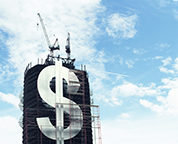New construction starts in December grew 5% to a seasonally adjusted annual rate of $554.5 billion, according to McGraw Hill Construction, a division of McGraw Hill Financial. Although both nonresidential building and housing settled back during the final month of 2013, the nonbuilding construction sector (public works and electric utilities) finished the year on a strong note.
For 2013 as a whole, total construction starts advanced 6% to $516.8 billion. This follows the 10% gain reported for 2012 (which drew support from a record amount of new electric utility starts that year) and modest 2% gains in both 2010 and 2011. If the volatile electric utility category is excluded, total construction starts in 2013 would be up 14%, following a 9% gain in 2012 and essentially flat activity during 2010 and 2011.
The December statistics produced a reading of 117 for the Dodge Index (2000=100), compared to 111 in November. This marked the third highest month for the Dodge Index during 2013, after September’s 118 and October’s 125. During the first eight months of the year, the Dodge Index had hovered within the fairly narrow range of 100 to 108 but then showed a stronger pace of activity during the final four months, reflecting in part the impact of several very large projects.
In December, large projects that were entered as construction starts included the $1.5 billion Goethals Bridge replacement project in New York and New Jersey, two large natural gas-fired power plants and two large manufacturing plants. For all of 2013, the Dodge Index averaged 109, up from 103 in 2012.
“The construction industry in 2013 made progress towards establishing a more broad-based recovery after several years in which the upturn was more limited in scope,” said Robert A. Murray, chief economist for McGraw Hill Construction. “Housing continued to lead the way, strengthening throughout much of 2013, and it was joined by a faster pace for commercial building, albeit from low levels. The institutional building sector registered a considerably smaller decline than in prior years, as its lengthy downturn appears to be ending.
“The public works sector in 2013 showed surprising strength, helped by the start of several major projects even amidst restrained government spending,” Murray said. “Running counter in 2013 was a steep drop for new electric utility starts, after the robust amount reported in 2012. For 2014, the prospects look good for total construction, with growth anticipated for housing and commercial building, while the institutional building sector at least stabilizes.”
Nonresidential Building
Nonresidential building in December slipped 7% to $168.6 billion (annual rate), pulling back for the second month in a row after its elevated pace in October, although its fourth quarter average was still 17% above what was reported in the first quarter.
Several commercial categories in December paused from the improved activity registered earlier in the fall. New office construction dropped 44% from November, which had been lifted by the start of such projects as the $336-million Transbay office tower in San Francisco; in contrast, the largest office projects entered as December starts were an $80-million office complex in Cary, N.C., and a $73-million data center in West Des Moines, Iowa.
Similar December declines were registered by hotels, down 42%; and warehouses, down 46%; although the latest month did include the start of an $88-million Amazon distribution center in Windsor, Conn. Store construction, which was the one commercial category that did not post a November gain, managed to increase 6% in December.
The December pause for nonresidential building was cushioned by a sharp 110% jump for manufacturing buildings, which reflected the start of two massive chemical plants in Louisiana, each valued at $500 million.
The institutional building categories in December were mixed. Educational facilities grew 5%, helped by the start of a $213-million medical research building in Boston and a $151-million college science building in Chicago. Health care facilities in December jumped 30% from the previous month’s subdued amount and featured groundbreaking for an $80-million hospital in Virginia and a $70-million cancer center in Wisconsin.
The smaller institutional categories generally weakened in December, with public buildings (courthouses and detention facilities) down 32%; churches, down 44%; and amusement-related work, down 46% (compared to the previous month, which included the $763-million Vikings Multipurpose Stadium in Minneapolis). The transportation terminal category retreated a slight 1% in December, and included the start of a $230-million terminal renovation project at Los Angeles International Airport.
For 2013 as a whole, nonresidential building increased 7% to $168.6 billion, shifting to an upward direction after the 5% decline reported for 2012. The commercial categories overall advanced 16%, faster than the 13% gain witnessed in 2012. The strongest gain by commercial category was registered by hotels, up 28%; followed by warehouses, up 27%; office buildings, up 17%; and stores, up 1%.

